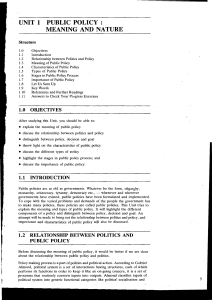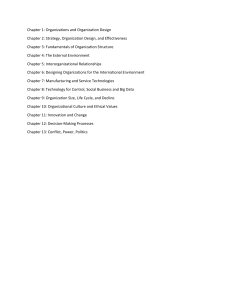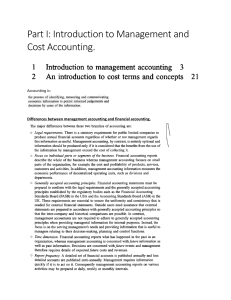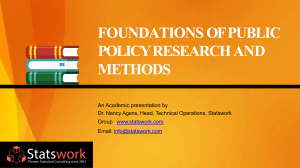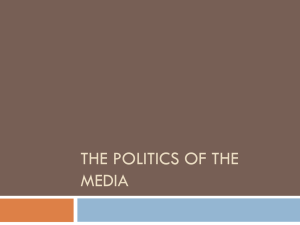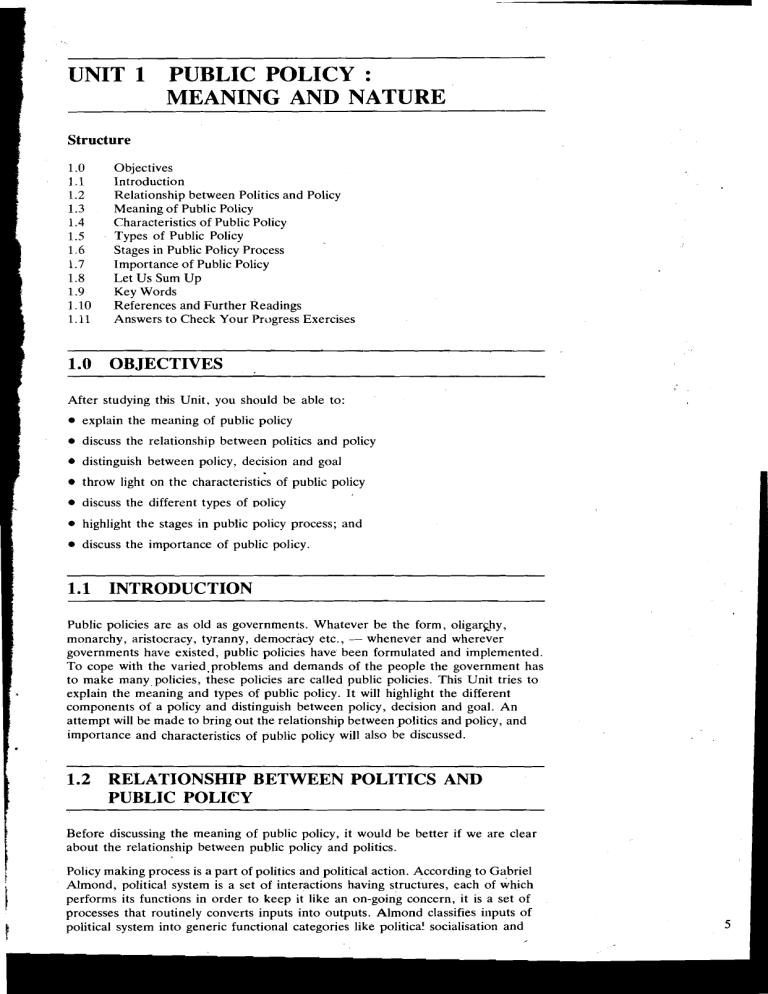
UNIT 1 PUBLIC POLICY : MEANING AND NATURE Structure 1.0 1.1 1.2 1.3 1.4 1.5 1.6 1.7 1.8 1.9 1.10 1.11 Objectives Introduction Relationship between Politics and Policy Meaning of Public Policy Characteristics of Public Policy Types of Public Policy Stages in Public Policy Process Importance of Public Policy Let Us Sum Up Key Words References and Further Readings Answers to Check Your Pragress Exercises 1.0 OBJECTIVES After studying this Unit, you should be able to: explain the meaning of public policy discuss the relationship between politics and policy distinguish between policy, decision and goal throw light on the characteristics of public policy discuss the different types of policy highlight the stages in public policy process; and discuss the importance of public policy. 1.1 INTRODUCTION Public policies are as old as governments. Whatever be the form, oligar~hy, monarchy, aristocracy, tyranny, democracy etc., - whenever and wherever governments have existed, public policies have been formulated and implemented. To cope with the varied.problems and demands of the people the government has t o make many policies, these policies are called public policies. This Unit tries to explain the meaning and types of public policy. It will highlight the different components of a policy and distinguish between policy, decision and goal. An attempt will be made to bring out the relationship between politics and policy, and importance and characteristics of public policy will also be discussed. 1.2 RELATIONSHIP BETWEEN POLITICS AND PUBLIC POLICY Before discussing the meaning of public policy, it would be better if we are clear about the relationship between public policy and politics. ! i F Policy making process is a part of politics and political action. According to Gabriel Almond, political system is a set of interactions having structures, each of which performs its functions in order to keep it like an on-going concern, it is a set of processes that routinely converts inputs into outputs. Almond classifies illputs of political system into generic functional categories like politica! socialisation and 5 Introduction to Public Policy recruitment, interest aggregation, interest articulation and political communication. Output activities are those which are carried on by a political system in response to demands or stresses placed upon the system in the form of inputs. Outputs can take the form of governmental policies, programmes, decisions etc. Another model on politics-policy relationship is the Feedback or the 'Black Box Model' coined by David Easton. According to this model the remaining demands which have not been included in the decisions and policies will again be fed back through the same process for the purpose of its conversion into decisions. These two models establish clear19 the relationship between politics and policies in a political system. . -. : 1.3 MEANING OF PUBLIC POLICY There are various studies about public policy and many scholars have attempted to define public policy from different angles. Before explaining the meaning of public policy, let us first go through some of its definitions. Robert EyeStone terms public policy as "the relationship of government unit to its environment. Thomas R. Dye says that "public policy is whatever government chooses to do or not to do" Richard Rose says that "public policy is not a decision, it is a course or pattern of activity. In Carl J. Friedrich's opinion public policy is a proposed course o: action of a person, group or government within a given environment providing opportunities and obstacles which the policy was proposed to utilise and overlcome in an effort to reach a goal 01 realise an objective or purpose. From these definitions, it is clear that publi: policies are governmental decisions, and are actually the result of activities which the government undertakes in pursuance of certain goals and objectives. It can also be said that public policy formulation and implementation involves a well planned pattern or course of activity. It requires a thoroughly close knit relation and interaction between the important governmental agencies viz., the political executive, legislature, bureaucracy and judiciary. The following points will make the nature of public policy more clear in your minds: 1) P,ublic Policies are goal oriented. Public policies are formulated and implemented in order to attain the objectives which the government has in view for the ultimate benefit of the masses in general. These policies clearly spell out the programmes of government. 2) Public policy is the outcome of the government's collective actions. It means that it is a pattern or course of activity or' the governmental officials and actors in a collective sense than being termzBdas their discrete and segregated decisions. 3) Public policy is what the government actually decides or chooses to do. It is the relationship of the government units to the specific field of political environment in a given administrative system. It can take a variety of forms like law, ordinances, court decisions, executive orders, decisions etc. 4) Public policy is positive in the sense that it depicts the concern of the government 'and involves its action t o a particular droblem on which the policy is made. It has the sanction of law and authority behind it. Negatively, it involves a decisions by the governmental officials regarding not taking any action on a particular issue. Policy and Goals T o understand the meaning of policy in a better manner, it is very important to make a distinction between policy and goals. Goals are what policies aim at or hope t o achieve. A goal is a desired state of affairs that a society or an organisation attempts to realise. Goais can be understood in a variety of perspectives. These can be thought of as abstract values that a society would like to acquire. There are also goals that are specific and concrete. Removal of poverty is a goal that the government wants to pursue. Public policies are concerned with such specific goals. They are the instruments which lead to the achievement of these goals. 6 .. - , I If the government announces that its goal is to provide housing to all the members of the deprived sections of society it does not become a public policy. It is a statement of intention of what the government wants to do. Many a time the government, for political reasons, announces goals that it has little desire to achieve. In order to become a policy, the goal has to be translated into action. Programmes have to be designed to achieve specific objectives. As an illustration, let us look at the policy of poverty alleviation. Several programmes have been designed for this, e.g., The Integrated Rural Development Programme (IRDP), The National Rural Employment'Programme (NREP) etc. Each programme has certain goals to achieve within a specified time and each programme is provided with financial resources and administrative personnel. These become concrete efforts to achieve a goal. Policy spells out the strategy of achieving a goal. Thus policy is essentially an instrument to achieve a goal. Statement of a goal docs not make it a policy. Public Policy : Meaning and Nature .- Policies and Decisions A distinction needs to be drawn between a policy and a decision also. Many a time the terms are used interchangeably but that is not the correct usage. Individuals, organisations or government are constantly taking decisions. But all the decisions that are taken cannot be descr;ibed as matters of policy. The essential core of decision-making is to make a choice from the alternatives available in order to take an action, if there is only one course of action available then there is nothing one can choose from and therefore, no decision can be taken. A decision can be taken only when there is more than one alternative available. Thus a decision is the act of making a choice. The entire science of decision-making has been developed in order to analyse the conditions that can improve this activity and how a decision maker can improve his choice by expanding the number of alternatives available to him. There can be two types of decisions, programmed and non-programmed. Programmed decisions are repetitive and do not require a fresh consideration every time they are taken. These decisions are routine in nature and for these definite procedures can be worked out. Each decision need not be dealt with separately. In programmed decisions, habits, skills and knowledge about the problem are important. For example, once the decision to open the library from 10 a.m. to 5 p.m. is taken, it does not require fresh c o n s i ~ ~ r a t i oton keep it open during those hours. The decision is incorporated into procedures that are established for the purpose. Non-programmed decisions are new and unstructured. No well laid-out methods are available for such decisions, each issue or question is to be dealt with separately. Such decisions are required in the situations of unprecedented nature, for example breakdown of an epidemic, occurrence of earthquake, etc. Training in skills, needed for such decisions and innovative ability become releiant in this regard. Both the programmed and non-programmed decisions have to be taken in a broad framework or course of action. 1 i Publlc policy is the broad direction or perspective that the government lays down in order to take decisions. Each organ~sationor the individual is enjoined to take a decision within a policy framework. Decision can be a one time action. Policy consists of several decisions that are taken to fulfil its aims. A policy consists of a series of decisions tied together into a coherent whole. There can be some similarity in the processes involved in decision making and policy making. Both are concerned with choice among alternatives and for both similar processes can be followed in generating alternatives. But we should always remember that policy is a more comprenensive term, as it encompasses a series of decisions and has a comparatively longer time perspective. 1.4 CHARACTERISTICS OF PUBLIC POLICY MAKING The pleaning and nature of public policy will become more clear by throwing light on different characteristics of public policy. Some of the major characteristics of public policy making are: 7 Introduction to Public Policy Public Policy Making is a Very Complex Process: Policy making involvcs many components. which are interconnected by communication and feedback loops and which interact in different ways. Some parts of the process are explicit and directly observable, but many others proceed through hidden channels that the officials themselves are often only partly aware of. These hidden procedures are very difficult. and often impossible to observe. Thus. gl~idelinesare often formed by a series of single decisions that result in a 'policy' without any one of the decision makers being aware of that process. It is a Dynamic Process: Policy making is a process, that is a continuing activity taking place within a structure; for sustainance, it requires a continuing input of resources and motivation. It is a dynamic process, which changes with time. the sequences of its sub-processes and phases vary internally and with respect to each other. Policy ~ a k i n gComprises Various Components: Thc complexity of public policy making as we know. is an important characteristic of policy making. Public policy formulation foten involves a great variety of substructures. The identity of these substructures and the degree of their involvement in policy making, vaiy because of different issues, circumstances and societal values. Policy Structure makes Different Contributions: This characteristic suggests that every substructure makes a different, and sometimes unique. contribution to public policy. What sort of contribution substructures make, depends in part on their formal and informal characteristics which vary from society to society. Decision-Making: Policy making is a species of decision-making because it lets us use decision-making models for dealing with policy making. Lays down Major Guidelines: Public policy, in most cases, lays down general directives, rather than detailed instructions, on the main lines of action to be followed. After main lines of action ha,ve been decided on, detailed sub-policies that translate the general theory into more concrete terms are usually needed to execute it. - Results in Action: Decision-making can result in action. in changes in the decision-making itself, o r both o r neither. The policies of most socially significant decision-making, such as most public policy making are intended to result in action. Also policies directed at the policy making apparatus itself such as efficiency drives in government are action oriented. Directed at the Future: Policy making is directed at the future. Thls is one of its most important characteristics since it introduces the ever-present elements of uncertainty and doubtful prediction that establish the basic tone of nearly all policy making. Actual policy making tends to formulate policies in vague and elastic terms; because the future is so uncertain. It permits policy makers to adjust their policy according to emerging facts and enables them to guard against unforeseen circumstances. Mainly Formulated by Governnrental Organs : Public policy is also directed. in part, at private persons and non-governmental structures, as 'when it calls for a law prohibiting a certain type of behaviour or appeals to citizens to engage in private saving. But public policy, in most cases, is primarily directed at governmental organs, and only intermediately and secondarily at other factors. Aims at Achieving what is in the Public Interest : However difficult it might be to find out what the "public interest" may c o ~ ,rely refer to, the term never the less 2nd seems therefore to be important conveys the idea of a "general" orientatio~~ and significant. Furthermore, there is good evidence that the image of "public interest" influences the public policy making process and is therefore at least, as conceived by the various public policy making units, a "real" phenomenon, and an important operational tool for the study of policy making. 8 Use of Best Possible Means: In abstract terminology, public policy making aims at achieving the maximum net benefit. Benefits and costs take in part the form of realised values and impaired values, respectively, and cannot in most cases be I expressed in commen~urableunits. Often, qua'ntitative techniques can therefore dot be used in this area of public policy making but neither the qualitative significance of maximum net benefhts as an aim nor the necessity to think broadly about alternative public policies in terms of benefits and costs is therefore reduced. public policy : Meaning and Nature Involvement of Various BodiesIAgencies: Industrial workers, voters, .intellectu.als; legislators, bureaucrats, political parties, political executives. judiciary- etc. are the various organs that participate in public policy making and can influence the policy process to a great extent. V 1) Bring out the relationship between public policy and politics. ......................................................................................................... ......................................................................................................... 2 ) Discuss the meaning of public policy. ......................................................................................................... ........................................................................................... ............. i ........................................................................................................ i 3) Distinguish between a policy and a goal. ......................................................................................................... ......................................................................................................... .......................................................................................................... * 4) Bring out the difference between a decision and a pubiic policy. ......................................................................................................... ......................................................................................................... ............................................................................. ......... ......................................................................................................... G A................. . 5) Highlight the different characteristics of public policy making. ......................................................................................................... ........................................................................................................... Introduction to Public Policy Substantive: These policies are concerned with the general welfare and development of the society, the programmes like provision of education and employment opportunities, economic stabilisation, law and order enforcement, anti-pollution legislation etc. are the result of substantive policy formulation. These policies have vast areas'of operation affecting the general welfare and development of the society as a whole. These do not relate t o any particular or privileged segments of the society. Such policies have to be formulated keeping in view the prime character of the constitution socio-economic problems and the level of moral claims of the society. Regulatory: Regulatory policies are concerncd with regulation of trade, business, safety measures, public utilities, etc. This type of regulation is done by independent organisations that work on behalf of the government. In India, we have Life Insurance Corporation, Reserve Bank of India, Hindustan Steel, State Electricity Boards. State Transport Corporations, State Financial Corporations, etc., which are engaged in regulatory activities. The policies made by the government, pertaining t o these services and organisations rendering these services are known as regulatory policies. Distributive: Distributive policies are meant for specific segments of society. I t can be in the area of grant of goods, public welfare or health services, etc. These mainly include all public assistance and welfare programmes. Some more examples of distributive policies are adult education programme, food relief, social insurance, vaccination camps ctc. Redistributive: Redistributive policies are concerned with the rearrangement of policies which are concerned with bringing about basic social and economic changes. Certain public goods and welfare services are disproportionately dividcd aniong certain segments of the society, thesc goods and service5 are streamlined through redistributive policies. Capitalisation: Under the capitali'sation policies financial subsidies arc given by the Union government to the state and local governments, such subsidies are also granted to the central and state business undertakings or some other important sphere if necessary. Capitalisation policies arc different in nature than the substantive, regulatory, distributive and redistributive policies as no provision for public welfare services is made through these. 1.6 STAGES IN PUBLIC POLICY PROCESS A brief highlight on the various stages of public policy will clarify the actual pr0ces.s of public policy in India. . t - 10 Policy formulation is the first stage in public policy process. Through this process the dernands of the system are converted into policies. But before this it has to be clearly established as to which demands require to be converted into policies. At the policy interpretation stage, the formulated public policy is further clarified and interpreted in order to make it fully understandable. 'I'he next stage in public policy process is policy education. The government through various channels of mass-media attempts to make the masses aware of the formulatc J policies. After this comes the stage of policy implementation, when the policics are systematically executed by the different admil~istrativeagencies at the central. \l:itc and !om1 Icvels. To ascertain the impact of policies, it is very essential to kcep an eye on the implementation process, to see that expenditure does not cxcced t h ~ I-csources . available and to see they are being made. For this that policies are eositively affecting those for whc~rl~ proper monitoring of policy implementation has to Ile done. and policy evaluation stage is the final stage in policy process. Proper and appropriate administrative and adjudicative functions are needed for keeping a conlplete control over the public policies. 1.7 THE GROWING IMPORTANCE OF PUBLIC POLICY Public Policy : Meanlng and Nature ' It is clear from the above sections of the Unit that policy is a purposive course of action in dealing with a problem or a matter of concern within a specific time frame. Before going into the question of importance which is attached to policy formulation, implementation and monitoring, it would be better to recapitulate the components of public policy. 1) Policy is purposive and delibbrately formulated. Policy must have a purpose or a goal. It does not emerge at random or by chance. Once a goal is decided the policy is devised in such a way that it determines the course of action needed to achieve that goal. 2) A policy is well thought out and is not a series of discrete decisions. 3) A policy is what is actually done and not what is intended or desired, a statement of goals does not constitute a policy. 4) Policy also delineates a time frame in which its goals have t o be achieved. 5) Policy follows a defined course of action viz. formulation, implementation, monitoring and evaluation. Actually the scope of public policy is determined by the kind of role that the State adopts for itself in a society. In the classical capitalist society, State was assigned a limited role and it was expected that the State would merely act as a regulator of social and economic activity and not its promoter. With the advent of planned view of development, State began tp be perceived as an active agent in ' promoting and shaping societies in its various activities. This was considered as a great change in the role of a State. Public policies expanded their scope from merely one of regulation to that of development. Expansion in scope led to several other consequences like many more government agencies afld institutions came into being in order to formulate and implement policies. In India, the Planning Commission and its attendant agencies came into being in order to formulate policies and develop perspectives that could define the direction which the country would follow. So, the first major goal of public policies in our country has been in the area of socio-economic development. Wide ranging policies were formulated in the area of industrial and agricultural development. Many policies were converted into Statutes. like Industrial Development and Regulating Act or Land Tenancy Act. Others were kept as directives in the various plan documents. For all policy directions, the Five Year Plans became the major source. These policies were of two types, one of regulation and the other of promotion. Laws laid down what could be done or not done by the entrepreneurs. This could be in the larger area like what goods can be produced by the public or whether certain goods can be tiaded only by government agencies. Laws also specified how State agencies themselves were to provide goods and services like electricity, transport etc. The State undertook similar responsibility in the social sphere. Dowry Act, Divorce Act, etc., are examples of this. But soclo-economic transformation was not the only problem when India became independent. There were also problems of national integrity, the external environment was a source of threat and the country had to develop suitable policies to defend itself. Apart from this, there have been internal challenges. Regionalism has given rise to fissaparious tendencies that have to be countered in the long-term perspective These would include not only defence policies but also similar efforts at decentralisation that create greater natlondl cohesiveness. Thus, since independence, public policies in India have been formulated with a view to achieve soclo-econo~nicdevelqment and maintain national integrity. These goals have been coinplex demanding coherent pollcies. This has been a difficult task because goals have had to be divided into sectors and sub-sectors. Many a time by its very n ~ t u r e ,pollcies have been contradictory. What may be rational for economic developmelt; a a y not be so for national Integration. Thps, the need of a strong Centre to cope with external threats etc. is important but it may go against the principle of decentralisation which provides for greater national cohesion of a heterogeneous society. This is the reason why ascertaining of the actual impact of public policy becomes a necessity. 11 These days policy analysis is acquiring a lot of importance in the realm of the study of public administration. This trend is observable all over the world. The success of policy tormulation, execution and monitoring ultimately depends on the success of policy analysis. In India, this trend emerged with the launching of our Five Year Plans. As the years passed by, one Five Year Plan was followed by another and disillusionment started setting in. Goals of socio-economic development could not be achieved. Those who were supposed to benefit from the development effort began to lose. Attention shifted to the management and administration in order to find out why the policies were failing to achieve their objectives. This investigation did not include the questions of policies being right or wrong. Introduction to ~ u h l i cPolicy . R took the crises of the 1960s to raise the issue of correctness of policy. Disenchantment with the development processes followed the two wars in 1962 and 1965. The International Monetary Fund (IMF) enforced a deul-!nation of the rupee in 1966 and a terrible drought ravaged the land during 1966-68. It became evident that the development policies were in trouble. In the early 1970s another war, drought and the oil crisis gave a jolt to the plan that had been followed uptil then. The culmination was the imposition of national emergency in 1975 to cope with the rising dissatisfaction. It was the emergence of the turbulent period that l ~ 10 d the questioning of the policies that had been followed. It was no more a question of implementation alone. The argument that began to gain the popular view was that policy itself was faulty and all the blame could not be put on administration. The first to pick up this line of reasoning was the discipline of economics. The economic failures dominated the scene and therefore it was natural that economists were the first ones to raise questions about t'he appropriateness of policy. Students of public administration began to emphasise that implementation failures could also emanate from inadequacy of public policy and therefore policy analysis should also be included in the area of study of public administration. This argument got support from certain developments in the discipline of public administration. In view of the everyday experience, it was becoming difficult to sustain the classical concept of separation of politics and administration. This distinction categorised policy formulation and implementation as two distinct activities. Policy formulation was regarded as a political activity and policy implementation an administrative one. But this distinction got increasingly blurred and it was not an easy task to determine where policy formulation ended and where policy implementation began. It came to be accepted that .both 'were interactive processes and had to be seen in an integrated way. With this change in view students of public administration began to devote greater attention to the problems of policy formulation and influence of policy design on implementation. It is in this way that policy analysis has become an important focus of study. Policy makers have also shows great interest in it because it ultimately helps in improving the effectiveness of policy. Many universities and research institutes are involved in policy analysis. The government provides for a lot of funds in this area. Check Your Progress 2 I Note : i) ii) Use the space given below for your answers. Check your answers with those given at the end of the Unit. 1) What are the different types of public policy. ......................................................................................................... 2) Highlight the various stages involved in public policy process. \ d - -Public Policy : Meaning and Nature ......................................................................................................... ......................................................................................................... ................................................. ........................................................ 1, I r 3) e Discuss the importance of public policy ......................................................................................................... F . ......................................................................................................... ......................................................................................................... ........................................................................................................ ......................................................................................................... 6 1.8 LET US SUM UP It is clear that public policies are the activities that the government undertakes in order to pursue certain established goals and objectives. In this Unit we discussed the meaning and ialportance of public policy and the difference between a publit policy, a goal and a decision. An attempt was also made to explain the relationship between public policy and politics. The Unit also highlighted the different types of public policy, the stages involved in public policy process and the various characteristics of public policy. Some of these aspects of public policy will be discussed in detail in the subsequent Units of this Block. 1.9 KEY WORDS Nnn-Programmed Decisions: Herbert Simon .makes a clear distinction between programmed and non-programmed decisions. Non-programmed decisions, are new, novel and unstructured. No ready made methods are available for taking these decisions, each issue is dealt with separately. Proper training in development of innovative capacity is reouired for such decisions. Programmed Decisions: These decisions are repetitive and routine in nature. For such decisions definite procedures can be worked out. Each decision need not be dealt with separately. In such type of decisions, habits, skills and knowledge about the problem is important. Mathematical models and computer can help the decision makers to arrive at rational'decisions as far as these decisions are concerned. 1.10 REFERENCES AND FURTHER READINGS Anderson, James E. 1975. Public Policy Making. Praeger: New York Dror Yehezkel, 1968. Public Policy Making Re-examined, Chandler. Pennsylonia Dye. Thomas R. 1972. Understanding Public Policy. Prentice Hall. Englewoodcliff Frohock. Fred M. 1979. Public Policy: Scope and Logic. Prentice Hall. Englewoodcliff Sahni Pardeep. 1987. Public Policy: Conceptual Dimensions. Kitab Mahal. Allahabad. Saigal Krishan, 1983. Policy Making in India :An Approach to Optimisation, Vikas: New Delhi. 13 ' Introduction to Public Policy 1.11 ANSWERS TO CHECK YOUR PROGRESS EXERCISES Check Your Progress 1 1) Your answer should include the following points : policy making is a part of politics and political action p~liticalsystem is a set of interactions having structures, each part of the structure performs certain functions. demands act as inputs which are continuously fed in the political system. these inputs get converted into programmes, policies and decisions. 2) Your answer should include the following points: public policies ,are governmental decisions. public policies are the result of the activities which the government undertakes in persuance of certain goals and objectives. it involves a wdl planned pattern or course of activity. it depicts the concern of the government and involves its actions. 3) Your,answer ~ h o u l dinclude the following points: goals are what policies aim at or hope to achieve: goals can be abstract, specific and concrete. goal is a statement of intention of hat the government wants to do. in order to become a policy a goal has to be translated into action. policy spells out the strategy of achieving a goal. 4) Your answer should include the following points: the essential core of decision-making is to make a choice from the alternatives available in order to .take an action a decision is an act of making a choice. there are two types of decisions, programmed and non-programmed. public policy is the broad direction or perspective that the government lays down in order to take decision. a decision can be a one time action. a policy consists of several decisions that are taken to fulfill its aims. both policy making and decision processes are concerned with choice activity. 5) Your answer should include the following points : public policy making is a complex process it is a dynamic process comprises various components its substructures make.different contributions decision-making lays down major guidelines result in action directed at the future formulated by governmental organs keeps in view the public interest use of best possible means involvement of various organs Check Your Progress 2 1) Your answer should include the following points: . Substantive Regnlatory Distributive Gipitalisation Redistributive 2) Yoor answer should include the following points : pdicy formuiation policy implementation monitoring of policy policy evaluation and analysis 3) Your answer should includc thc following points : Ihc reach irnd scopc ol' public policy is dctcrmined by the kind of role that the Statc adopts for itsclf in a society. public policies have cxpanded their scope from merely of regulation to that of development. many policies have been converted into legal statutes. . many aspects like socio-economic development, maintenance of national integrity, political stability have forrncd a major part of public policies in India. policy analysis ha's acquired a lot of importance in the realm of public policy process. the failure of our Five Year Plans has pressurised the governnlent and research institutions to go deep into research on policy analysis. realisation that when policies fail only policy implementation should not be blamed has gained importance. policy formulation and implementation can no longer be regarded as two distinct activities. Public Policy : Meaning and Nature
